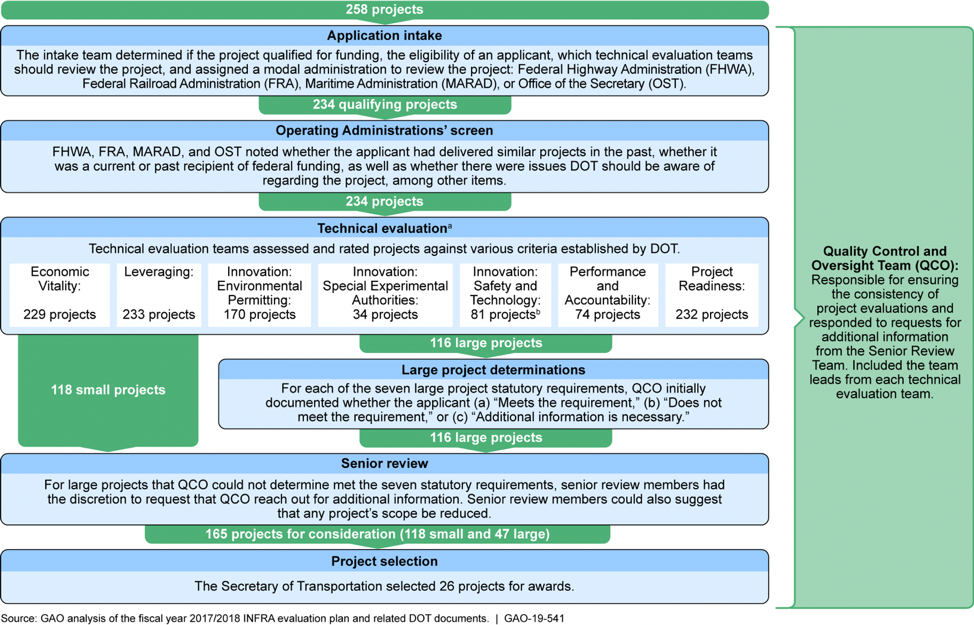This week the U.S. Department of Transportation announced $856 million in new federal grants for transportation projects through its INFRA program. The program awards went to 20 projects across the country, providing critical funding to some of the nation’s most pressing infrastructure needs. According to statute, the grants should go toward highway and freight projects that are supposed to meet federal goals and demonstrate with economic analysis that they are some of the best infrastructure projects in the country.
At least that is how the process is supposed to work. A new report from the U.S. Government Accountability Office (GAO) again calls into question the transparency of the USDOT process, echoing earlier findings and recommendations from GAO and Eno.
The calls for increased transparency are longstanding and cross administrations. GAO released its first report and recommendations for discretionary grant programs in 2011, calling for consistent and transparent project evaluations. Eno released a similar report evaluating the TIGER program in 2012 that called for more transparency in decision making. Other reports from Eno, GAO, and others on discretionary grant programs at DOT reached similar conclusions. In this most recent report, frustrated GAO staff recommended that Congress impose more stringent requirements for transparency and process consistency, as their calls for USDOT to do so have been unsuccessful.
GAO describes the process that USDOT used to evaluate and select projects for the 2017/2018 series of funding (see graphic below). They highlight that some of the requirements for the process are in statute, such as specifics for rural and small project set-asides and funding allocated for non-highway projects. However, the legislative language is much less specific with its direction for selection criteria. The law states that projects “will be cost-effective” and will contribute to national goals but does not specify a mechanism for calculating cost-effectiveness nor a way to evaluate how these criteria fit within the selection framework. Unfortunately, the opacity of the process does not allow for GAO or others to truly understand how the final selection occurs.

The GAO did a good job of pointing out the lack of transparency and consistency in the DOT selection process. But it is equally important to highlight why such features are so important to a federal program.
A transparent and consistent process results in better projects
Labor groups, businesses, engineers, and transportation users all call for more federal investment in infrastructure. Without substantial new revenues, the federal government, states, and localities must target their resources to the most effective projects. However, GAO found that USDOT evaluators had very low confidence in the benefit-cost ratios of 14 of the 26 awarded projects in the 2017/2018 period. Of these low-confidence projects, 11 had benefit-cost ratios between 1.0 and 1.5, meaning the projects easily could have costs greater than benefits. For example:
…a technical reviewer noted, “… we conclude that the benefits of this project are reasonably likely to exceed its costs, though the case is very marginal and highly uncertain, as even a small change in some of the key assumptions and parameters could result in a negative finding.”
In fact, two of the small projects that received awards had benefit-cost ratios of less than 1.0. Awarding millions of dollars to projects whose costs may outweigh their benefits does not mesh with the growing need for funding. GAO was not able to answer why U.S. DOT did not select another project out of the 258 applicants that were more qualified. If infrastructure is going to improve, we must target limited resources to only the best of projects.
A transparent and consistent process results in improved projects
GAO not only highlighted a sub-par process, but also noted problems with giving feedback to project sponsors to improve their current and future applications. As they found:
“… reviewers noted that additional information could help them determine whether a project met the statutory requirements (such as whether the project was cost-effective) but less than half of the projects had the chance to provide such information.”
Some proposed projects are simply bad projects and do not deserve federal funds. Others could be good projects but need to improve design or outcomes to meet clear federal criteria. Without a transparent process and full disclosure of how a project scored, project sponsors do not have the ability to assess opportunities for improvement to make their proposals worthy of federal assistance.
A transparent and consistent process builds trust in the program
The BUILD (formerly TIGER) program has lasted a remarkable 9 years since it first received funding, and INFRA (formerly FASTLANE) is authorized for the entire 5 years of the FAST Act. These types of programs represent a significant potential for infusing analysis and data to back funding decisions at the federal level. But if project sponsors, states, and members of Congress grow frustrated with what they see as an opaque and unfair process, they will lose faith in the program and its political support will decline.
While transparency invites increased criticism from project applicants, stakeholders, and members of Congress, this criticism can be used to refine and improve the project selection process, resulting in better projects and better outcomes for limited federal dollars.




